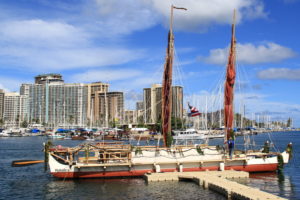 The previous 6 days had the crew living and sleeping on Nāmāhoe while docked at METC. This experience gave some of the newer crew members a sampling of life at sea during a long voyage. However, the task for the crew was to make modifications to the yokes of the booms, replace and relash 3 of the stancions, and assist the sailmakers of North Sails as they were scheduled to attach newly made canvases for Nāmāhoe and make any needed adjustments. An added bonus to being there was the visiting of many past voyagers of Hōkūle’a, Hawaii Loa, Makaliʻi, and Hikianalia. The crew got meet these voyagers of the past and listen to the adventures of their voyages.
The previous 6 days had the crew living and sleeping on Nāmāhoe while docked at METC. This experience gave some of the newer crew members a sampling of life at sea during a long voyage. However, the task for the crew was to make modifications to the yokes of the booms, replace and relash 3 of the stancions, and assist the sailmakers of North Sails as they were scheduled to attach newly made canvases for Nāmāhoe and make any needed adjustments. An added bonus to being there was the visiting of many past voyagers of Hōkūle’a, Hawaii Loa, Makaliʻi, and Hikianalia. The crew got meet these voyagers of the past and listen to the adventures of their voyages.